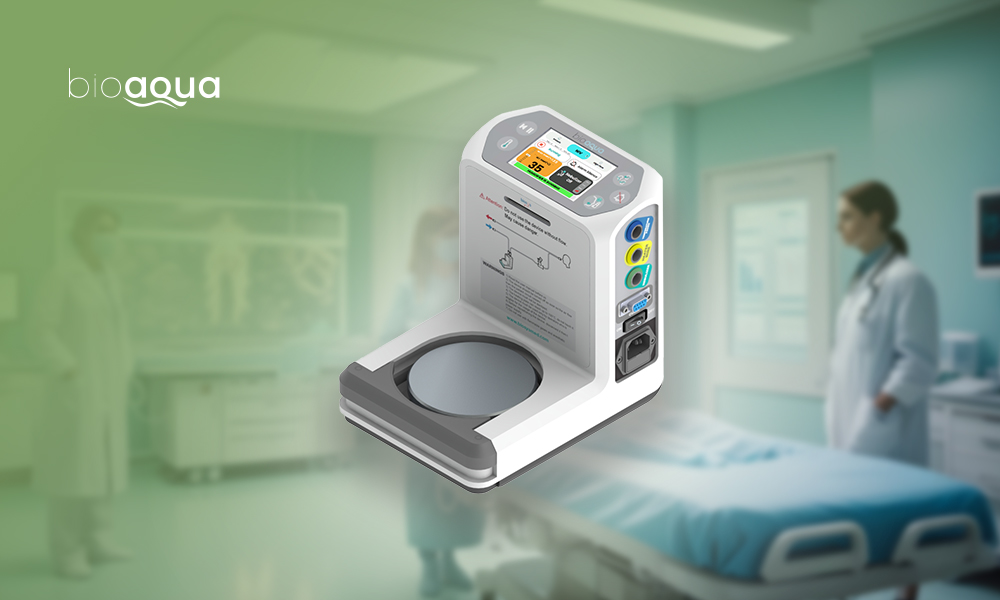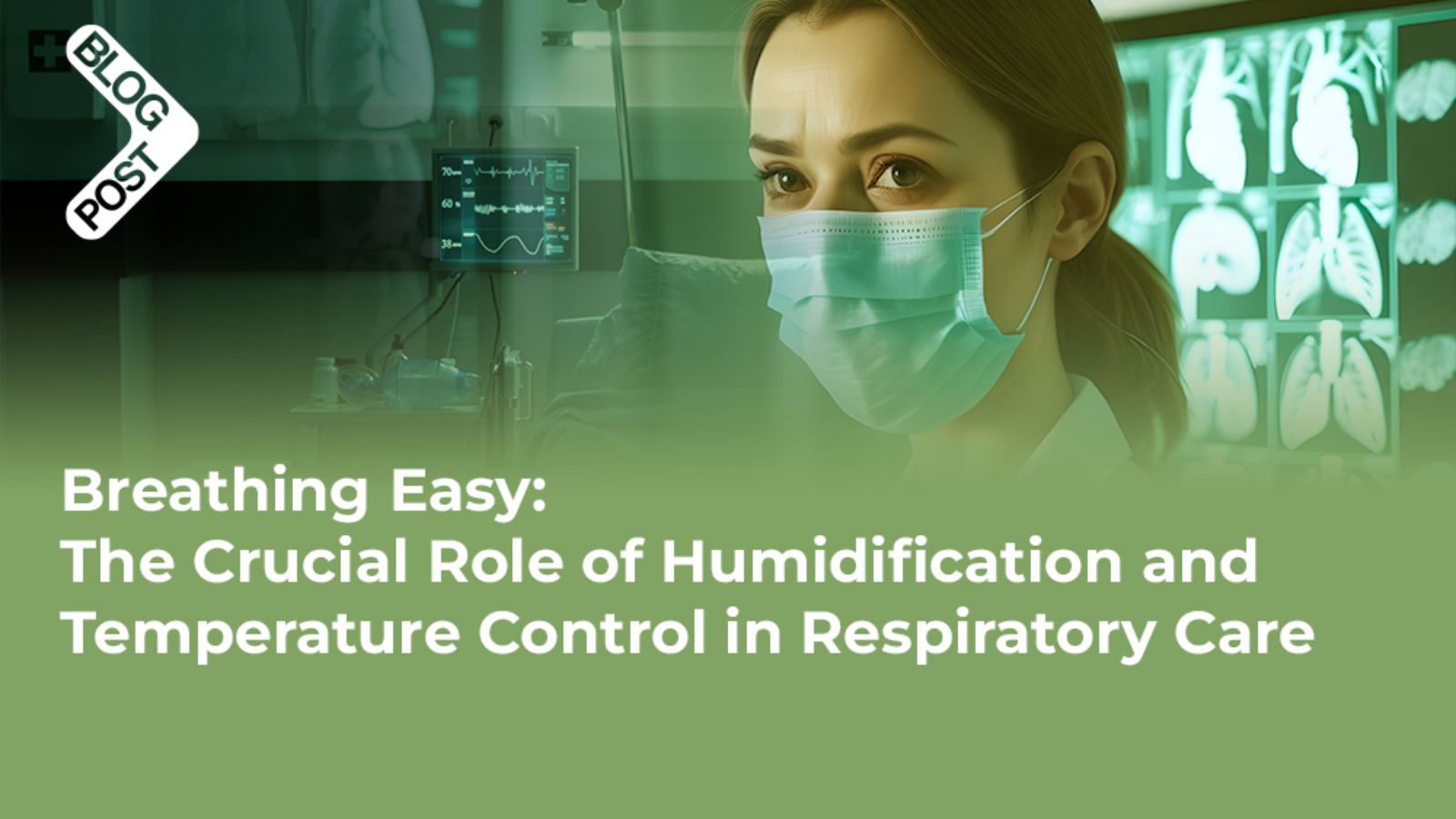Humidity and temperature control have long been standard care procedures in mechanical ventilation. It has been stated in many articles published over the years that dry gases damage the airways. For this reason, external humidification and heating devices are used in respiratory care to tolerate the lack of natural humidification factors. Reservoirs, wires, heating devices and other systems have become standard equipment in intensive care units.
Controlling Humidity and Temperature in Respiratory Care
One of the important functions of the respiratory system is to ensure heat and moisture exchange in the inhaled air. The nasal connective tissue, which is the first organ of inspiration, has many capillaries. These are responsible for increasing the moisture-carrying capacity of the inhaled air by heating it.
The air passing through the nose and descending into the respiratory tract reaches a temperature of 37°C and 100% relative humidity. Cells in the respiratory tract maintain the mucosal layer, which traps pathogens and is an interface for moisture exchange. However, moisture capacity is more limited in the lower respiratory tract. Therefore, poor humidification after endotracheal intubation causes potential damage to the respiratory epithelium; this is manifested by increased work of breathing, atelectasis, thick and watery secretions, and cough and/or bronchospasm.
While it is controversial whether additional heat and humidity are always necessary in cases such as non-invasive mechanical ventilation where the upper airway is not bypassed, active humidification is always recommended. Active or passive humidifier systems are used in patients on mechanical ventilation.

The Importance of Maintaining Proper Respiratory Care Conditions
While humidification is mandatory in tracheostomy or intubated patients, this is optional in non-invasive ventilation. Humidifying the airway of a patient under ventilation support is one of the important interventions of the intensive care process. An inappropriate humidifier type and setting can damage the airway and increase respiratory workload, leading to adverse outcomes. The choice of humidifier may vary depending on clinical situations, and healthcare professionals should be aware of its advantages and disadvantages when choosing the appropriate medical devices.
Challenges In Achieving Optimal Conditions
Respiratory care’s dynamic and diverse nature creates challenges in achieving optimal conditions. Traditional methods frequently lack the precision required to tailor conditions to the needs of individual patients. Variations in environmental factors, patient-specific requirements, and the requirement for real-time adjustments add to the difficulties. Inconsistent humidity and temperature control can result in discomfort, poor therapeutic outcomes, and a higher risk of respiratory complications.
Solutions for Keeping Good Conditions
Innovative solutions in healthcare technology, such as the Bioaqua humidifier, address the challenges of maintaining proper respiratory care conditions. These devices include various features designed to optimize humidity and temperature levels, resulting in a comfortable and practical therapeutic environment for patients.
Bioaqua’s adjustable humidity control settings enable healthcare providers to tailor treatment plans to individual patient requirements. Incorporating innovative technology allows for remote monitoring and adjustments, allowing for a more proactive approach to patient care. The device’s user-friendly interface makes it accessible to healthcare professionals and patients, improving the overall respiratory therapy experience.
The Bioaqua humidifier has temperature control that is seamlessly integrated and maintains an optimal temperature range. This is achieved by utilizing advanced heating elements and thermal control systems. These technical features work together to help the device provide a tailored and responsive approach to humidity and temperature control in respiratory care.
Impact on Respiratory Conditions Examples
COVID-19 patients are among the patient groups for which invasive or non-invasive ventilation is most frequently used. Kumar et al. (2021) recommend in their article that active heat and humidification improve functions by clearing secretions from the airway in COVID-19 patients. They stated that this increased the patient’s comfort and improved NIV tolerance.
A study was conducted in 2020 to evaluate whether heated humidified ventilation could improve the prognosis in normothermic thoraco-abdominal aortic aneurysm repair operations. In this study, patients were divided into two group: the group using heated ventilation and water blankets and the group using water blankets only. Intraoperative core temperature, coagulation functions and in-hospital mortality were analyzed in the study. As a result, less blood loss, anti-coagulant dose and in-hospital mortality were observed in the heated and humidified ventilation group.
Respiratory care is extremely important, especially in newborns. A study conducted in 2015, which investigated the effect of adding heated and humidified gas to the treatment during birth and newborn arrival on body temperatures in premature babies, showed that humidification is more effective in preventing hypothermia.

The Role of Bioaqua Humidifiers in Innovative Solutions
Bioaqua stands out as an innovator in the humidification device market. Bioaqua humidifiers are designed with advanced technologies to control humidity levels precisely, ensuring optimal patient therapeutic conditions. These devices include adjustable humidity settings, real-time monitoring, and adaptive algorithms that cater to the user’s needs. Smart technology integration enables healthcare providers to monitor and adjust settings remotely, promoting a more personalized and responsive approach to patient care.
The Bioaqua humidifier incorporates temperature regulation, addressing the challenges associated with temperature control in respiratory care. The device maintains a precise temperature range, reducing the risk of complications caused by high temperatures. Bioaqua is an invaluable asset in the respiratory care landscape due to its comprehensive approach to humidity and temperature control.
Collaboration in the Development of Effective Solutions
The advancement of advanced humidification devices such as Bioaqua demonstrates the value of collaboration among respiratory therapists, clinicians, and technology experts. These collaborations result in devices that not only meet the immediate needs of patients but also pave the way for continuous improvement in respiratory care by combining clinical expertise with technological innovation.
Incorporating the perspectives of respiratory therapists and clinicians ensures that the technology meets the practical needs of healthcare settings. The collaboration of medical expertise and technological innovation is critical for developing devices that are user-friendly, adaptable, and capable of addressing the wide range of challenges posed by respiratory conditions.
Balancing Humidity And Temperature: An Essential Factor In Respiratory Care
Harmony between humidity and temperature control is critical for patient well-being and therapeutic success in the intricate dance of respiratory care. Bioaqua humidifiers are the pinnacle of innovation in this field, with advanced features designed to meet patients’ and healthcare providers’ changing needs.
While navigating the complex landscape of respiratory health, it is clear that collaboration among respiratory therapists, clinicians, and technology experts is critical in developing effective solutions. The Bioaqua humidifier exemplifies what can be accomplished when expertise and innovation come together to create devices that revolutionize respiratory care.
We invite you to visit our website to learn more about the transformative capabilities of Bioaqua humidifiers and to experience firsthand the benefits of advanced therapeutic humidity and temperature control in pulmonary care. Take the first step towards breathing easier and learn how Bioaqua can make a difference in the lives of those who require respiratory support.
Allow Bioaqua to assist you in your pursuit of optimal respiratory health.
If you would like to get detailed information about this revolutionary device, you can browse our catalogue and get the details from the link. For our other products, follow the link.
References
- Al Ashry HS, Modrykamien AM. Humidification during mechanical ventilation in the adult patient. Biomed Res Int. 2014;2014:715434. https://doi: 10.1155/2014/715434.
- Michael P. Meyer, David Hou, Nazmul N. Ishrar, Ingrid Dito, Arjan B. te Pas, Initial Respiratory Support with Cold, Dry Gas versus Heated Humidified Gas and Admission Temperature of Preterm Infants, The Journal of Pediatrics, Volume 166, Issue 2,2015, Pages 245-250.e1, https://doi.org/10.1016/j.jpeds.2014.09.049.
- Ruben D Restrepo and Brian K Walsh, Humidification During Invasive and Noninvasive Mechanical Ventilation: 2012, Respiratory Care May 2012, 57 (5) 782-788; DOI: https://doi.org/10.4187/respcare.01766
- Rui Zhao, Jiawei Qiu, Jinlin Wu, Wenxiang Jiang, Enzehua Xie, Wei Gao, Cuntao Yu, Juntao Qiu, Effect of heated humidified ventilation on intraoperative core temperature and prognosis in normothermic thoraco-abdominal aortic aneurysm repair, Journal of Thoracic Disease, 2020, Vol 12, No 3 (March 23, 2020), doi: 10.21037/jtd.2020.01.61
- Amarjeet Kumar, Chandni Sinha, Abhyuday Kumar, Neeraj Kumar, Ajeet Kumar, Kunal Singh, Prabhat Kumar Singh, Inefficient humidification as the cause of noninvasive ventilation failure in COVID-19 patients, Brazilian Journal of Anesthesiology (English Edition), Volume 71, Issue 6, 2021, https://doi.org/10.1016/j.bjane.2021.07.021.


Add a Comment